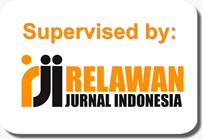FOOD COMPOSITION AND HALAL AWARENESS AGAINST INTENTION TO BUY FAST FOOD WITH HALAL CERTIFICATE AS AN INTERVENING VARIABLE
Abstract
The aim of the research is to analyze the effect of food composition and halal awareness on the intention to buy fast food with halal certificates as an intervening variable, research in the city of Bukittinggi, the research object of the millennial generation who likes to consume fast food. The population of the Millennial generation aged 15-39 years is 57,099. Non-probability sampling technique, purposive sampling method. The sampling method is the Hair et.al method, the research indicators are 11, the sample is set at 110. The data is processed using the Smart PLS Software. The results of the study found that food composition and halal awareness had a positive and significant effect on the millennial generation's purchase intention of fast food. Halal awareness has no positive and significant effect on purchase intention. The results of the study also found that food composition did not have an indirect effect on the intention to buy fast food in the millennial generation with halal certificates as an intervening variable. Halal awareness does not have an indirect effect on the intention to buy fast food in the millennial generation with halal certificates as an intervening variable.
Full Text:
PDFReferences
Abror, A.; Patrisia, D.; Trinanda, O.; Omar, M.W.; Wardi, Y., (2021). Antecedents of word of mouth in Muslim-friendly tourism marketing: the role of religiosity. J. Islam. Mark., 12(4): 882–899. Emerald Publishing Limited, .
Agustina, D., (2020). Pengaruh Islamic Branding. IAIN BENGKULU, .
Ajzen, I., (1985). From intentions to actions: A theory of planned behavior. Action Control (pp. 11–39). Springer, .
Ajzen, I., (1991). The theory of planned behavior. Organ. Behav. Hum. Decis. Process., 50(2): 179–211. Elsevier, .
Ali, M.H.; Tan, K.H.; Makhbul, Z.M.; Ngah, A.H., (2016). Augmenting halal food integrity through supply chain integration. J. Pengur. (UKM J. Manag., 48.
Avkiran, N.K., (2018). An in-depth discussion and illustration of partial least squares structural equation modeling in health care. Health Care Manag. Sci., 21(3): 401–408. Springer, .
Aziz, Y.A.; Chok, N.V., (2013). The role of Halal awareness, Halal certification, and marketing components in determining Halal purchase intention among non-Muslims in Malaysia: A structural equation modeling approach. J. Int. Food Agribus. Mark., 25(1): 1–23. Taylor & Francis, .
Azmi, F.R.; Abdullah, A.; Musa, H.; Wan Mahmood, W.H., (2020). Perception of food manufacturers towards adoption of halal food supply chain in Malaysia: Exploratory factor analysis. J. Islam. Mark., 11(3): 571–589. Emerald Publishing Limited, .
Cohen, J., (1988). Statistical power analysis Jbr the behavioral. Sci. Hillsdale Lawrence Erlbaum Assoc., : 18–74.
Dealwis, C.; Johari, A.; Morni, A., (2022). The Perception of Non-Muslim Tourists towards Halal Tourism: A Case Study in Kuching, Sarawak. Proc. Borneo Islam. Int. Conf. eISSN 2948-5045 (Vol. 13, pp. 1–12).
Fadila, C.T.; Farlian, T.; Ramly, A., (2020). The influence of Halal Label, Product Quality, and Price on Purchasing Decisions. J. Financ. Islam. Bank., 3(1): 95–133.
Fornell, C.; Larcker, D.F., (1981). Evaluating structural equation models with unobservable variables and measurement error. J. Mark. Res., 18(1): 39–50. Sage Publications Sage CA: Los Angeles, CA, .
Hair Jr, J.F.; Sarstedt, M.; Ringle, C.M.; Gudergan, S.P., (2017). Advanced issues in partial least squares structural equation modeling. saGe publications, .
Haro, A., (2016). Understanding TPB model, availability, and information on consumer purchase intention for halal food. Int. J. Bus. Commer., 5(8): 47–56.
Henseler, J.; Ringle, C.M.; Sarstedt, M., (2015). A new criterion for assessing discriminant validity in variance-based structural equation modeling. J. Acad. Mark. Sci., 43(1): 115–135. Springer, .
Izzuddin, A., (2018). Pengaruh Label Halal, Kesadaran Halal dan Bahan Makanan Terhadap Minat Beli Makanan Kuliner Jember. Pros. Ekon. Kreat. DI ERA Digit., 1(1).
Khan, M.I.; Haleem, A., (2016). Understanding “Halal” and “Halal Certification & Accreditation System”-A Brief Review. Saudi J. Bus. Manag. Stud., 1(1): 32–42.
Listyoningrum, A.; Albari, A., (2017). Analisis Minat Beli Konsumen Muslim Terhadap Produk Yang Tidak Diperpanjang Sertifikat Halalnya. J. Ekon. dan Keuang. Islam, 2(1): 40–51. Faculty of Economics, Universitas Islam Indonesia, .
Mahendra, W., (2020). The Influence of Religiusity and Halal Label through Halal Awareness Purchase Decisions. Budapest Int. Res. Critics Institute-Journal, : 1739–1746.
Mujiono, F.V.S., (2018). Analisis Pengaruh Label Halal, Pendapatan Dan Harga Produk Terhadap Preferensi Konsumen Dalam Keputusan Pembelian Produk Makanan Impor. Universitas Brawijaya, .
Nasfi, N.; Yunimar, Y.; Sabri, S.; Eka, F.; Asnah, A., (2021). The effect of profit sharing and financing ceiling on non-performing financing islamic banks. Inov. J. Ekon. Keuang. dan Manaj., 17(4): 850–858.
Pramintasari, T.R.; Fatmawati, I., (2017). Pengaruh Keyakinan Religius, Peran Sertifikasi Halal, Paparan Informasi, dan Alasan Kesehatan Terhadap Kesadaran Masyarakat Pada Produk Makanan Halal. J. Manaj. Bisnis, 8(1): 1–33.
Rahim, R.; Alfajri, D.; Nasfi, N., (2021). Determinant factors affecting the value of manufacturing companies in indonesia. Inov. J. Ekon. Keuang. dan Manaj., 17(2): 344–354.
Rezeki, F., (2023). The Influence 0f Transformational Leadership Style, Organizational Culture and Organizational Communication On Employee Job Satisfaction. Asian J. Manag. Entrep. Soc. Sci., 3(01): 698–714.
Sang, S.; Lee, J.; Lee, J., (2010). E‐government adoption in Cambodia: a partial least squares approach. Transform. Gov. People, Process Policy. Emerald Group Publishing Limited, .
Sihombing, S.O., (2004). Hubungan sikap dan perilaku memilih satu merek: Komparasi antara theory of planned behavior dan theory of trying. Desertasi. Univ. Gadjah Mada, Yogyakarta.
Suandi, E, Lukman, S, Primalita, R, Rahim, R, Nasfi, N., (2020). Relationship Between Blue Ocean Strategy, Customer, And Islamic Bank Performence. J. Ipteks Terap., 14(2): 60–71.
Suhatman. S, Nasfi, N., (2021). Economic Analysis Affecting Tourist Demand on the Number of Visitors to the Gondoriah Pariaman Beach Tourism Object. Ilomata Int. J. Soc. Sci., 2(1): 11–20.
Wandel, M., (1997). Food labelling from a consumer perspective. Br. food J. MCB UP Ltd, .
Yuliza, M.; Desri, M.; Nasfi, N., (2021). Effect of Work Movements, Job Promotion, and Compensation towards Employee Performance. J. Akuntansi, Manaj. dan Ekon., 23(1): 9–18.
DOI: https://doi.org/10.31846/jae.v11i2.636
Refbacks
- There are currently no refbacks.

This work is licensed under a Creative Commons Attribution-NonCommercial-NoDerivatives 4.0 International License.
e-Jurnal Apresiasi Ekonnomi Indexed by:












